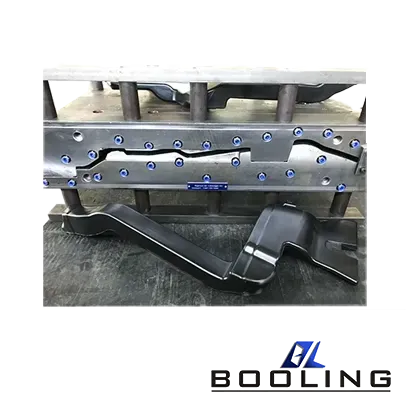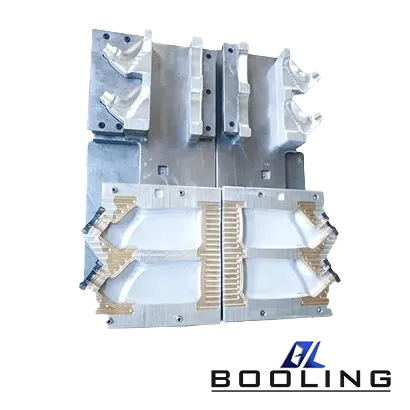Home > Blow Moulding Technologies: Production of Plastic Products
Plastic Blow Molding
The basic working principle of plastic blow molding is to inflate the softened thermoplastic billet, making it tightly adhere to the cooling surface of the closed mold. The inflated billet solidifies, forming a hollow plastic product.

Blow moulding technologies mainly use air compression to blow and deform the softened thermoplastic placed in the mold, making it a hollow product.
The plastic products produced by blow moulding technologies have outstanding characteristics such as stable quality, good environmental performance, easy recycling, high production efficiency, low cost, durability and beauty, diverse and flexible appearance, etc. The internal tension of the products is small, and the risk of part deformation is low. Manufacturers typically use ABS blow molding technology to process car bumpers, as well as HDPE blow molding technology to make car air ducts and other components, which play a significant role in the production of automotive parts.

Blow Molding Process
The basic processing flow of blow moulding technologies mainly includes three steps, namely the melting and plasticization of plastics, the forming of preforms, and blow molding. The advantages of this process technology are very prominent.
Workmanship
Stage 1: Plasticization of Raw Materials
Use an extruder or injection molding machine to heat and melt the raw materials to a certain temperature.
Stage 2: Forming of Billet
Use extruder heads and mouth molds or injection molds to form preforms.
Stage 3: Blow Molding
Utilize an auxiliary air compressor to provide compressed air and use a hydraulic clamping device to clamp the purple mold to form the product.
In the process of blow molding, the first step is to produce tubular billets, which can be produced using extruders or injection molding machines. This process is often referred to as the performing stage in blow moulding technologies. The main principle and process of blow molding is to feed the heated billet or blank into the blow molding mold, clamp the billet while the mold is closed, and then blow the heated billet onto the low-temperature inner wall of the mold to adhere tightly. After cooling and shaping, the product is ejected. In the vast majority of cases, hollow products require post-processing after blow molding, such as removing burrs, printing, labeling, loading products, etc. Some drilling and grinding operations on the products can be completed by automated equipment.
-Advantages
One of the main advantages of blow moulding technologies is that there is little or no waste generated during the processing, which can effectively control the wall thickness of the control product and the dispersion of the material. Especially for some fine-necked products, the molding accuracy is high, and the surface of the product is relatively smooth, which can be produced in small batches and has a certain degree of economy. Moreover, the product can achieve a seamless bottom, thus having high strength, precise mouth size, and blow-molded products with high rigidity, strength, hardness, creep resistance, surface glossiness, and sealing performance. It has a certain resistance to some chemical agents such as oil, grease, acid, and alkali, and has a wide range of applications.

Key Points of Blow Moulding Technologies for Plastic Products
Although plastic blow moulding technologies are simpler in process and design than injection molding technology, it still needs to follow certain technical points, such as:
- Appearance
When designing the appearance of hollow products, consideration should be given to the convenience and flexibility of processing, and sharp corners should be minimized as much as possible to prevent the material from being unable to form.
- Structural Strength and Stiffness
In blow moulding technologies, to consider the structural strength and stiffness of the product, manufacturers may consider designing the product as a joint structure with geometric shapes such as folded edges, ribs, and intersecting two flat plates.
- Product Slope
All surfaces parallel to the direction of mold movement should have a certain slope, which should make it easy to open the mold and facilitate the removal of the product.
- Inflation Ratio
In the blowing process of blow moulding technologies, manufacturers should pay special attention to areas that cause extremely thin geometric shapes, which may usually be protruding or recessed. When the width-to-depth ratio is too large, manufacturers can use vacuum forming for processing.
- Check All Usage Functions
When using products produced by blow moulding technologies as a product, the fewer components and assembly work, the better, as it can reduce product costs
- Radius
When designing molds, try to avoid sharp edges, corners, sudden changes in surface, and sudden changes in product diameter or wall thickness.

What are the Blow Molding Techniques?
Blow moulding technologies can generally be divided into hollow blow molding and film blow molding, and hollow blow molding can be further divided into extrusion blow molding, injection blow molding, and stretch blow moulding. These several technologies have similar but different processes.
-Hollow Blow Molding
- Extrusion Blow Molding
Squeezing blow molding is one of the most widely used methods in blow moulding technologies, making plastic packaging containers one of the most widely used methods. The powder and particles of plastic are melted and plasticized by an extruder and then made into a heated melt tube-shaped billet. Once the billet exceeds the preset length, it enters the mold, the mold immediately closes, and then blow molding is carried out.
The characteristics of this molding method mainly include a high degree of automation, high manufacturing efficiency, balanced temperature of the billet, wide allowable range of shape, size, and wall thickness of the hollow container, strong adaptability, high flexibility, high compressive strength of this blow molding technology, simple mechanical equipment, and low engineering investment. But there are also some defects, such as low precision of handicrafts, the internal cavity of the external thread changing with the surface external thread, and there is a seam at the bottom of the container, which is not aesthetically pleasing.
- Injection Blow Molding
Injection blow molding is the process of using a plastic machine to inject a preform into a core shaft. After the preform is cooled to the appropriate temperature, the core shaft and the preform are fed into a blow molding tool. The blow molding tool closes and compresses the air introduced by the core shaft, promoting the expansion of the preform and the production of necessary handicrafts. The product is removed after cooling and solidifying to a certain degree.
The characteristics of this molding method are: there are no seams at the bottom of the handicraft, high aesthetics, no need for post-renovation treatment, and high precision of external threads and bottle stoppers. The inner cavity of the head and neck is on a smooth circle, which can be produced in large quantities with less auxiliary mechanical equipment required. The bottom of the product has high compressive and tensile strength, less raw material consumption, uniform wall thickness, and high manufacturing efficiency. However, the project investment in mechanical equipment is large, the production cycle is long, and the blow molding process requires highly technical operators. The appearance should not be too complicated, and it is suitable for manufacturing small and medium-sized high-precision containers.
- Stretch Blow Molding
Stretch blow molding technology refers to a molding method that uses a stretching rod to perform radial stretching and then immediately carries out blow molding. In addition, during the molding process, biomolecules are orderly fixed on the walls of the artwork, greatly improving the performance of plastic containers in terms of usage and appearance.
The characteristics of this molding method are low scrap rate, high manufacturing efficiency, easier control of the quality and weight of each product, and high consistency. The physical properties of the product have been changed, with better fracture toughness, improved rigidity, improved compatibility, and smoothness, as well as good barrier and sealing performance. However, the temperature control regulations for the stretch blow molding process are relatively high, and the investment in mechanical equipment projects is relatively large.
-Film Blow Molding Process
- Advantages
Compared with other process methods, using blow moulding technologies to produce films has the following advantages: simple equipment design and manufacturing, low investment, and fast yield cycle; The equipment has a compact structure, occupies a small area, and occupies less factory space; After stretching and blowing, the mechanical strength of the film becomes higher; The waste generated by the product is minimal or even non-existent, meeting the concept of sustainable development.
- The disadvantages of other film blow moulding technologies are as follows:
Poor control of film thickness uniformity; The production line speed is relatively low, resulting in lower output compared to rolling, casting, and stretching methods.
- Common materials
LDPE, HDPE, LLDPE, PA, PP, PS, EVA, PVC, etc.
- Process
(1) Flat squeeze blowing method
This method uses a right-angle die, which means that the discharge direction of the die is perpendicular to the extruder, the extrusion tube ring is upward, and after being pulled to a certain distance, it is clamped by a zigzag plate. The extruded tube is inflated into a bubble tube by compressed air introduced from the bottom, and its transverse size is controlled by the amount of compressed air. The longitudinal size is controlled by the pulling speed. The bubble tube is cooled and shaped to obtain blown film. As shown in the figure. The main plastic varieties suitable for upward-blowing methods include PVC, PE, PS, PA, PVDC (vinylidene chloride), and EVOH.
(2) Flat Squeeze-Down Blowing Method
The process of using a right-angle machine head and a bubble tube led out from below the machine head is called the flat extrusion blow-down method. This method is particularly suitable for raw materials with low viscosity and plastic films that require high transparency. Such as PP, PA, PVDC, and EVOH.
(3) Flat Squeezing and Flat Blowing Method
The flat extrusion flat blowing machine head is a center type, which uses a flat head concentric with the extruder screw. The process in which the bubble tube and the center line of the head are on the same horizontal plane is called the flat extrusion flat blowing method. This method is only suitable for blowing products with small caliber films, such as LDPE, PVC, and PS films. The flat-blowing method is also suitable for blowing heat-shrinkable films.
The update of blow moulding technologies is just around the corner, and plastic manufacturing also needs faster technology to emerge, which can greatly improve the utilization efficiency of plastic products.
Related News
Applied’s expertise in modifying materials at atomic levels and on an ihdustrial scaleenables our customers to transform possibilities into reality.




